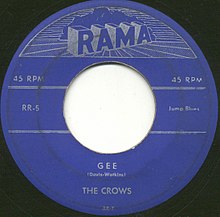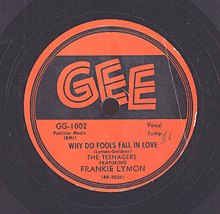George Goldner
George Goldner (born January 1, 1918 in New York ; † April 15, 1970 ibid) was an American music publisher and owner of several independent record labels, who had specialized in rhythm and blues in the 1950s .
Career
Goldner had started as a employed mambo teacher in dance halls in New York and New Jersey. Latin American music was his passion, and from 1945 this style gained popularity in the USA. However, he no longer wanted to passively consume this as the owner of dance halls, but instead wanted to actively intervene in the music business. To do this, he founded the record label Tico Records in 1948 , named after a Latin American standard Tico-Tico no Fubá . He soon succeeded in winning artists for the new label. Influential bands such as Tito Puente , Joe Loco, Machito and Tito Rodríguez were acquired. Puente alone is said to have recorded 156 recordings for the Tico catalog. Goldner could not occupy more than a niche with this, because his catalog did not make it into the charts. Puente left the label during a production stop at Tico Records in 1955.
In order not to become dependent on this niche offer, Goldner concentrated on rhythm and blues in parallel and began to systematically search the streets of New York for “Streetcorner harmony groups”. Since Tico was identified with Latin American music, he founded the record label Rama Records in early 1953 , whose offices were at 220 West 42nd Street. “Race music” should be recorded here - as R&B was still called back then. With catalog no. "Rama 5" he got access to the hit parade. He picked up the quartet The Crows in Harlem between 142nd Street and 7th Avenue, took them to a recording studio and had them set their own composition Gee in April 1953. However, the audience response didn't come until March 1954, when it made it to # 14 on the pop charts. The song went down in pop annals as one of the first rock & roll songs thanks to a fast dance rhythm. The Valentines (from September 1955) and Harptones (from November 1956) joined the label. Since radio stations only played a limited number of records by the same label in their programs, Goldner founded the Gee Records label in November 1955 , named after the piece Gee , his first hit parade as a record boss. For this he recruited The Cleftones and Frankie Lymon & the Teenagers . The Cleftones released the label's first record in December 1955 with You Baby You , which reached # 78 in the pop charts with 150,000 records. Then came the breakthrough with Frankie Lymon & The Teenagers. The third record by the young Gee label came out on January 10, 1956, Why Do Fools Fall in Love , sold 100,000 copies in the first 3 weeks, a total of 2 million, and became a good crossover (# 6 pop, # 1 R&B Charts). In 1956 - without waiting for any further success of the labels - he sold 50% of his shares in Gee Records to Joe Kolsky.
Roulette Records
The record company Roulette Records , founded by Goldner in December 1956 , became the best-selling of all the labels he had ever founded. Morris Levy was named president. She had most of the artists under contract and was broadly positioned with pop, jazz, rhythm and blues, country and western and even classical music. The line-up, with Hugo (Peretti) and Luigi (Creatore) as A&R people, Richard Barrett, Sammy Lowe , Joe Reisman , Henry Glover and Teddy Reig as producers, was more extensive than at his other labels. Even the label's first acquisition turned out to be a stroke of luck: Buddy Knox With The Rhythm Orchids , to be assigned to rockabilly , landed at number one on the pop charts with his Party Doll , released in February 1957, and sold a million records with it. Shortly thereafter, Hugo and Luigi discovered folk-pop singer Jimmie Rodgers , whose first single Honeycomb , released in July 1957, also landed at # 1.
As early as April 1957, Billboard magazine reported that Goldner had sold its holdings in Roulette, Rama, Gee and Tico to the Morris Levy empire. However, Goldner remained involved in the administration and was able to help expand the catalog of 18 interpreters at Roulette.
Other record labels
Goldner stayed true to his pattern. In early 1957 he founded the labels End and Gone Records . As a producer he got Richard Barrett, the lead singer of the Valentines, who had a deep understanding of music and was also able to develop a feeling for talent. Barrett discovered the girl's quintet Chantels with the good lead singer Arlene Smith. Barrett's production of He's Gone with the Chantels was released as End 1001 in August 1957 and became a medium success. The great success came with Maybe / Come My Little Baby (End # 1005), recorded on October 16, 1957 in a church in Midtown Manhattan , which after its release in December 1957 advanced to # 15 Pop / # 2 R&B. A further increase was achieved with Tears on My Pillow by Little Anthony & the Imperials , published in July 1958 and rewarded Goldner with the highest chart position of this label to date (# 4 Pop / # 2 R&B). The Flamingos had already been with 4 labels before they were signed to End Records in December 1958. But here they landed their biggest hit. In April 1959 they covered the oldie I Only Have Eyes For You , a spectacular ballad with harmonies under echo and a flowing falsetto (# 11 Pop, # 3 R&B).
The Isley Brothers , known as real label hoppers, released two singles on Gone from February 1958, but without leaving an impression. The Dubs made a more impression with their first Gone single Don't Ask Me To Be Lonely / Darling (Gone # 5002), which came on the market in June 1957 and hit the charts with a # 72. In August 1957, Could This Be Magic / Such Lovin was created , which reached # 23 Pop after its release in October 1957. The dubs were an example of vocal clean doo-wop that was only attractive to the pop charts and never to the R&B charts. The folk-pop author and singer Jackie DeShannon celebrated the beginning of her later career when she released the single I'll Be True / How Wrong Was I on June 3, 1957 as Gone # 5008 . It was only later that she became famous as the author of world hits like Needles And Pins . With Spanish Twist / My Kind of Woman , which was published on August 21, 1961, Bill Haley, who had left Decca Records, tried to participate in the twist wave with little conviction (Gone # 5111). The band followed Riviera / War Paint (Gone # 5116) in October 1961, before they migrated to the even smaller label Orfeon.
Most of these productions were stylistically similar. Clear lead and bass voices, often mixed with a cappella intonations, and onomatopoeic word inserts with sparing instrumentation mixed together to create a style that was known as the doo-wop sound. The majority of the productions took place in the Bell Sound Studios in New York, since Goldner did not have his own recording studios.
“Goldner disappeared from the scene in just 3 months. His shares in Roulette, Tico, Rama and Gee were completely transferred to Morris Levy, ”reports the star magazine Variety .
New activities
As part of the payola scandals Goldner was in January 1960 due to bribery of disc jockeys convicted. In February 1960 he launched Goldisc Records , on which the early Temptations and Little Richard appeared with 20 gospel songs. In 1962, George Goldner sold the successful End aud Gone labels to Morris Levy (who already owned Roulette Records with the sub-labels).
In April 1964, Goldner met the successful authors and producers Jerry Leiber and Mike Stoller , who were looking for an administrative partner for their new Red Bird Records label. They gave him a dozen master tapes to hear his opinion on their commercial potential. He selected Chapel of Love from the Dixie Cups , which was then released as Red Bird 001 on April 16, 1964 and which reached number 1 on the pop charts with sales of over 1.2 million. Further successes with the Dixie Cups, Shangri-Las and Ad-Libs followed. The extremely successful partnership lasted until April 1966, when Leiber and Stoller sold their shares in Goldner for a symbolic dollar. Goldner held Red Bird until 1967, but without Leiber / Stoller and the creative collaborators Jeff Barry / Ellie Greenwich and George "Shadow" Morton there were no more hits. Goldner's last attempt to start again with the formation of Firebird Records failed in December 1969. The next month, one of New York's most important record bosses died of a heart attack.
Everyone in the industry knew why Goldner had to keep selling his labels, which were currently in a phase of success: Goldner suffered from severe gambling addiction (horse betting) and was therefore forced to sell his record labels in order to reduce gambling debts.
Web links
Individual evidence
- ↑ played by Xavier Cugat in 1944
- ↑ About.com : Latinmusic
- ↑ There was a dispute between founding partners George Goldner and Art “Pancho” Raymond.
- ↑ Jay Warner: American Singing Groups . 2006, p. 137
- ↑ Charlie Gillett, The Sound of the City , 1996, p. 76. It was the first million-seller of the doo-wop singing style.
- ^ Jay Warner, American Singing Groups , 2006, p. 243
- ↑ With this song - as with many others - Goldner appears as a composer, although his compositional contribution was denied. This behavior, known as cut-in , secured Goldner additional income from royalties . He told the inexperienced group that only 2 authors could be registered - Goldner and Frankie Lymon. See Beatpatrol about Goldner
- ^ And his donors Morris Levy and Phil Khals; Levy was u. a. Owner of the famous Birdlands .
- ^ Charlie Gillett, The Sound of the City , 1996, p. 115
- ^ Billboard Magazine , April 6, 1957
- ↑ Tico Records was sold to Fania Records in 1974 and released the last record in 1981
- ↑ in the original by Eddy Duchin from 1934
- ↑ Variety , December 2000, pp. 208 f. (PDF) ( Memento from February 15, 2006 in the Internet Archive )
- ↑ Tony Fletcher, All Hopped Up and Ready to Go: Music From the Streets of New York 1927-77 , 2009, p. 122
- ↑ Soulmusic HQ via Goldner
| personal data | |
|---|---|
| SURNAME | Goldner, George |
| BRIEF DESCRIPTION | American composer and music producer |
| DATE OF BIRTH | January 1, 1918 |
| PLACE OF BIRTH | New York , United States |
| DATE OF DEATH | April 15, 1970 |
| Place of death | New York , United States |



